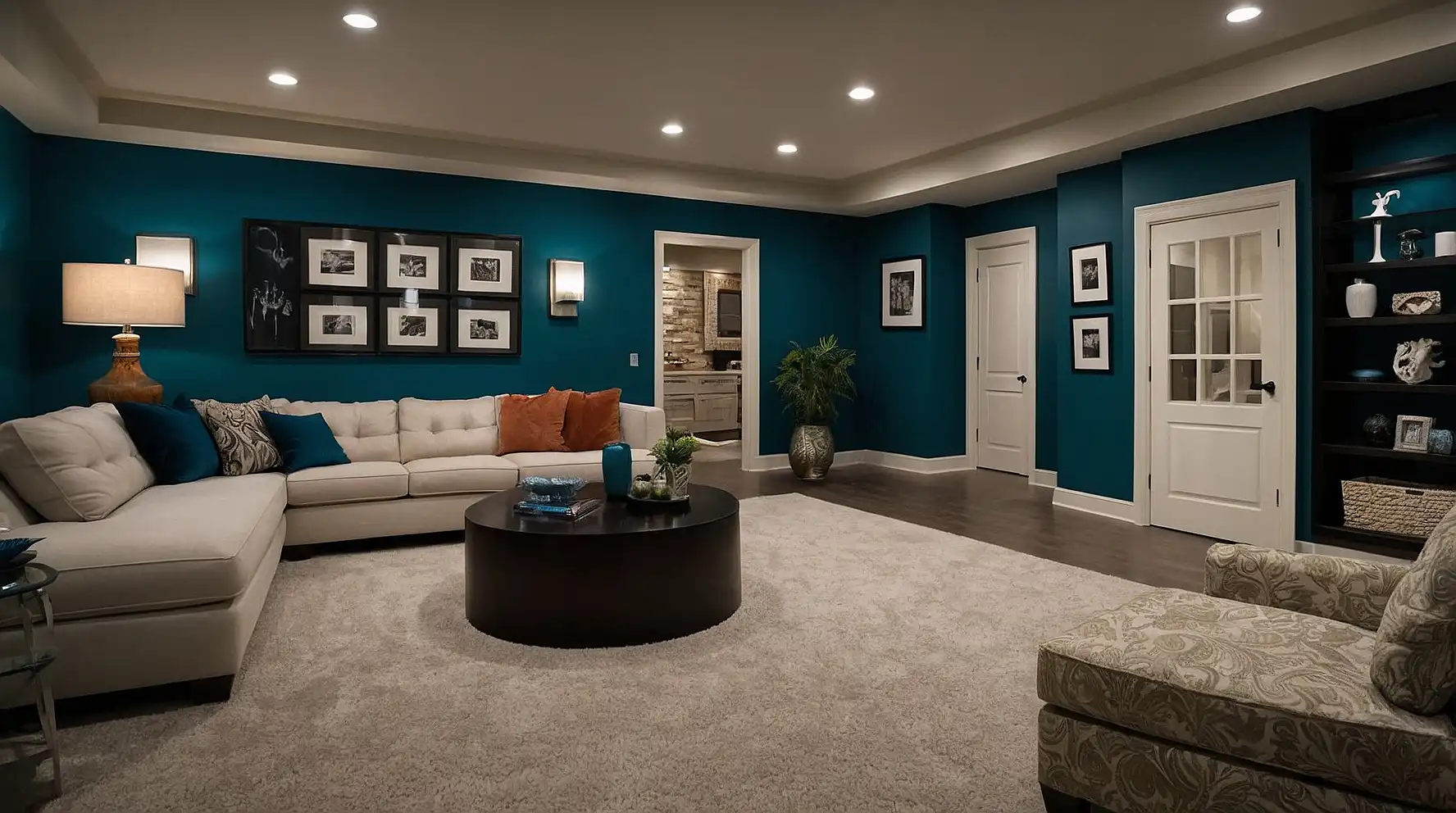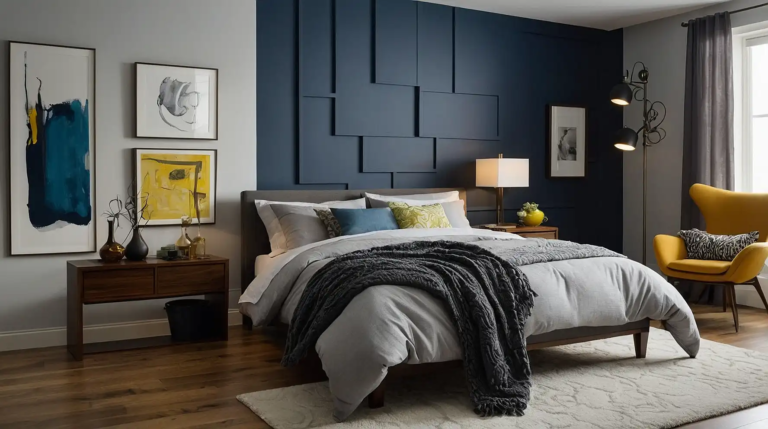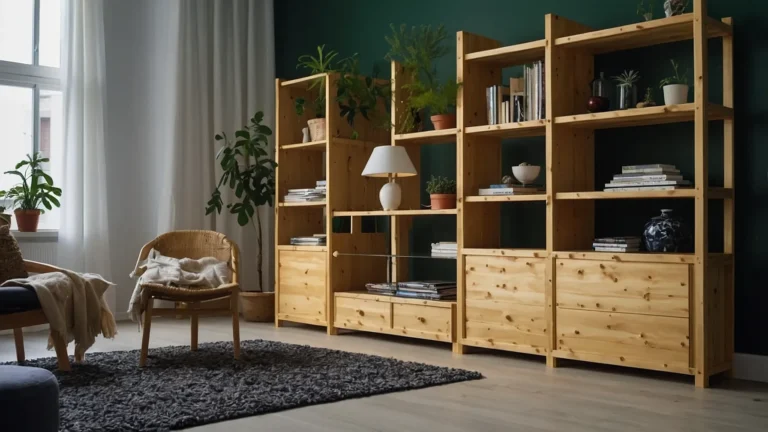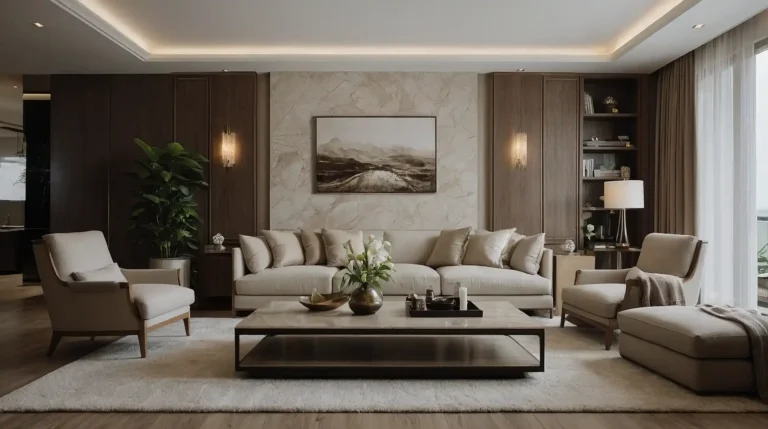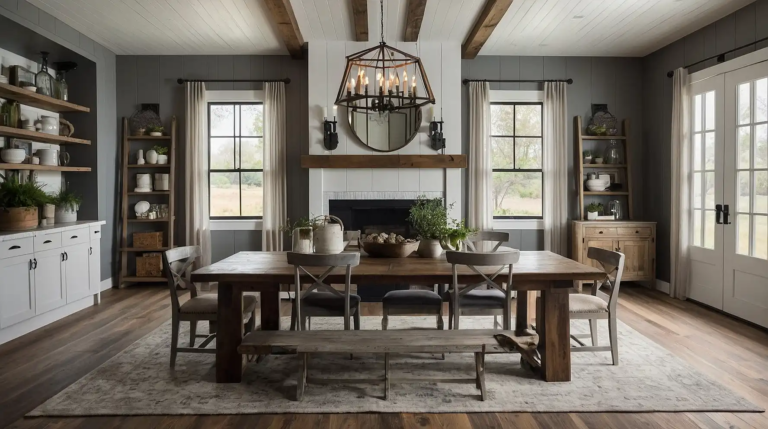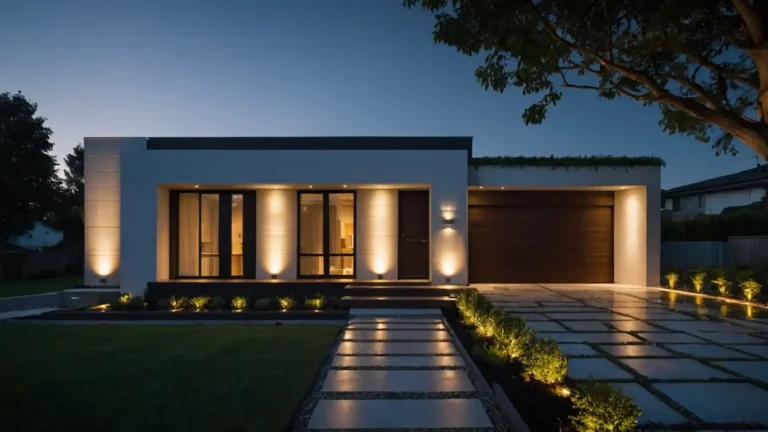27 Best Basement Paint Colors to Transform Your Underground Space
Choosing the right paint color for your basement can completely transform this often overlooked space into a cozy, inviting area of your home.
Unlike upper floors, basements typically receive minimal natural light, making your color selection even more crucial for creating the right atmosphere.
With the right paint choice, you can visually expand your space, brighten dark corners, and create a welcoming environment that you’ll actually want to spend time in.
1: Soft Warm White

Soft warm whites like Benjamin Moore’s “White Dove” create an airy, open feeling in basement spaces while avoiding the clinical look of pure whites.
This versatile neutral provides a perfect backdrop for any decorating style. The subtle warmth counteracts the natural coolness found in below-grade spaces.
Add contrast with darker furniture and accessories to prevent the space from feeling flat or washed out.
2: Light Greige

Greige (a gray-beige hybrid) like Sherwin-Williams “Agreeable Gray” offers the perfect balance between cool and warm undertones, making it ideal for basements with limited natural light.
This chameleon-like neutral adapts beautifully to different lighting conditions throughout the day.
It pairs wonderfully with both wood tones and modern furnishings.
The subtle depth prevents the walls from appearing flat while still reflecting available light.
3: Pale Blue-Gray

Colors like Behr’s “Light French Gray” bring a subtle hint of color while maintaining a sophisticated, neutral backdrop for your basement space.
This versatile shade creates a cool, calming atmosphere without making the room feel cold. The blue undertones add interest without overwhelming the space.
Consider this color for basement family rooms or recreational areas where a relaxed vibe is desired.
4: Butter Yellow

A soft, buttery yellow like Benjamin Moore’s “Hawthorne Yellow” brings instant warmth and cheerfulness to basement spaces that lack natural sunlight.
This color creates the illusion of sunshine even in completely underground rooms.
The subtle golden glow makes the space feel more inviting and less like a traditional basement.
Yellow works particularly well in basement playrooms, craft areas, or any space where you want to encourage creativity and positive energy.
5: Soft Sage Green

Gentle sage tones like Sherwin-Williams’ “Sea Salt” bring nature-inspired tranquility to underground spaces while maintaining excellent light reflection.
This versatile color bridges the gap between true neutrals and statement colors.
The natural associations help connect your basement to the outdoors it’s separated from.
Sage pairs beautifully with wooden elements, plants, and natural textiles to create a cohesive, earthy aesthetic.
6: Warm Taupe

Rich, warm taupe like Benjamin Moore’s “Pale Oak” creates a sophisticated, cozy environment perfect for basement media rooms or entertaining spaces.
This versatile neutral has enough depth to add interest without absorbing too much light.
The warm undertones counteract the natural coolness of underground spaces.
Taupe creates a perfect backdrop for artwork and decorative elements to shine against.
7: Lavender Gray

Subtle lavender-gray blends like Behr’s “French Lilac” add an unexpected yet sophisticated dimension to basement spaces while maintaining excellent light reflection properties.
The barely-there purple undertones create visual interest without feeling obviously purple.
This refined choice adds personality while remaining versatile enough to work with various decorating styles.
Consider this color for basement bedrooms, home offices, or meditation spaces where a calm but interesting backdrop is desired.
8: Warm Pewter

Mid-tone pewter shades like Sherwin-Williams’ “Mindful Gray” provide the perfect balance of warmth and sophistication for basement spaces.
This color family adds subtle dimension to walls without absorbing too much light. The depth creates a cozy atmosphere without making the space feel smaller.
Pewter tones pair beautifully with both cool and warm accent colors, making them incredibly versatile for any basement function.
9: Soft Coral

Gentle coral tones like Benjamin Moore’s “Coral Essence” bring unexpected warmth and energy to basement spaces that need a cheerful lift.
This color family creates a flattering glow that makes everyone look their best in artificial light.
The warm undertones counteract the cool feeling often found in underground spaces.
Consider this for basement guest rooms, craft spaces, or anywhere you want to create an energetic yet welcoming atmosphere.
10: Sky Blue
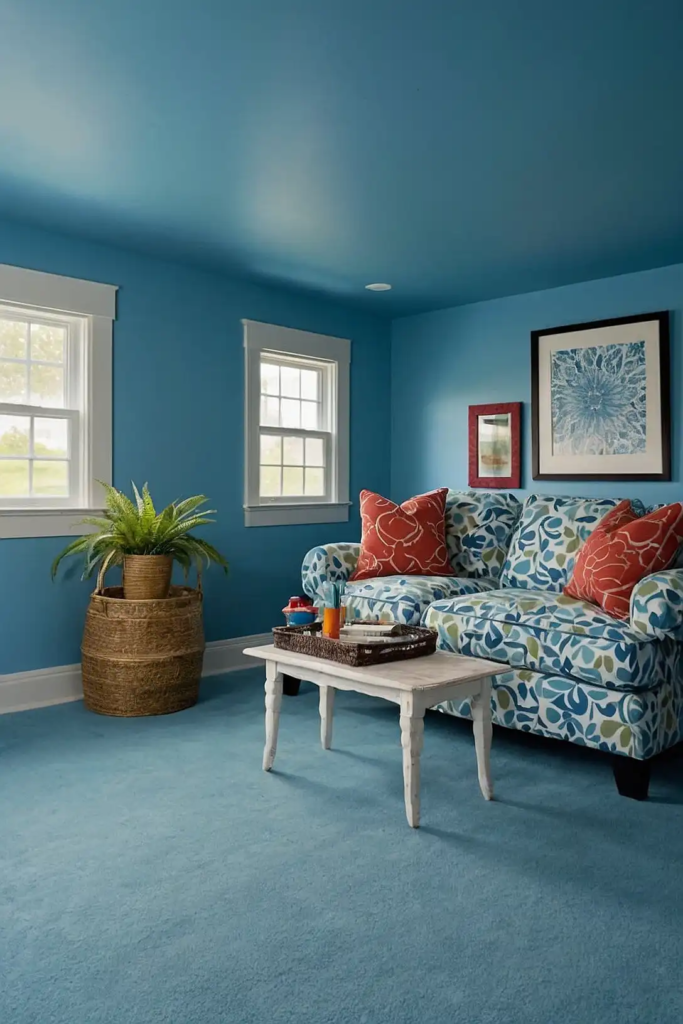
Light, airy blues like Behr’s “Watery” create the illusion of daylight and openness in windowless basement spaces.
This color family psychologically connects to the sky, helping underground spaces feel less confined. The cool undertones create a fresh, clean atmosphere.
Sky blue works particularly well in basement bathrooms, laundry areas, or home gyms where a refreshing environment is desired.
11: Warm Linen

Soft, fabric-inspired neutrals like Sherwin-Williams’ “Natural Linen” add subtle texture and warmth to basement walls without overwhelming the space.
This color family reflects light beautifully while adding more character than plain white.
The slight texture in these hues helps disguise minor wall imperfections common in basements.
Pair with natural materials like jute, wood, and cotton for a cohesive, organic aesthetic.
12: Pale Mint

Fresh mint tones like Benjamin Moore’s “Fresh Mint” bring a refreshing, unexpected energy to basement spaces while maintaining excellent light reflection.
This color creates a subtle statement without overwhelming the space. The cool undertones create a crisp, clean feeling even in underground environments.
Consider this for basement home offices, craft rooms, or exercise spaces where an energizing atmosphere supports productivity.
13: Warm Mushroom

Earthy mushroom tones like Behr’s “Mocha Foam” create a grounded, sophisticated backdrop for basement living spaces or wine cellars.
This color family adds dimension and warmth without absorbing too much light.
The natural associations help create a more organic feeling in underground spaces.
Mushroom tones pair beautifully with leather, wood, and metal accents for a tailored, masculine aesthetic.
14: Soft Terracotta

Muted terracotta shades like Sherwin-Williams’ “Hushed Auburn” bring desert-inspired warmth to basement spaces lacking natural light.
This color family creates instant coziness without feeling heavy or dated.
The earthy qualities help ground the space and create a connection to the natural world.
Consider this for basement family rooms, game rooms, or anywhere you want to create a gathering-friendly atmosphere.
15: Pale Aqua

Soft aqua tones like Benjamin Moore’s “Glass Slipper” add a refreshing, spa-like quality to basement spaces while maintaining a neutral flexibility.
This color creates a subtle water association that feels clean and rejuvenating.
The blue-green balance works beautifully in artificial lighting conditions typical in basements.
Aqua pairs wonderfully with wood tones, creating a perfect balance of cool and warm elements.
16: Creamy Beige

Rich, creamy beiges like Behr’s “Almond Wisp” create a warm, welcoming environment perfect for basement entertaining spaces.
This color family reflects light beautifully while adding more warmth than stark whites.
The yellow undertones counteract the cool feeling common in underground spaces.
Beige provides a perfect backdrop for more colorful furniture and accessories to shine.
17: Dusty Blue

Muted, sophisticated blues like Sherwin-Williams’ “Upward” add character and depth without absorbing too much precious basement light.
This color family creates a calming atmosphere perfect for basement retreats. The gray undertones keep the color from feeling too childlike or coastal.
Consider this for basement guest suites, reading nooks, or media rooms where a relaxing environment is desired.
18: Soft Sand

Natural, beach-inspired neutrals like Benjamin Moore’s “Manchester Tan” bring outdoorsy warmth to underground spaces.
This color family creates a subtle backdrop that pairs with virtually any decorating style.
The slight yellow undertones counteract basement coolness without looking obviously yellow.
Sand tones work beautifully in basement spaces that serve multiple purposes, as they adapt well to different lighting conditions.
19: Pale Smoky Purple

Subtle, smoky purple tones like Behr’s “Dusty Lilac” add unexpected sophistication to basement walls while maintaining excellent light reflection.
This color family creates a unique atmosphere without feeling overly feminine or childlike. The gray undertones keep the purple sophisticated and mature.
Consider this for basement home offices, craft studios, or wine cellars where an unexpected but refined backdrop is desired.
20: Warm Khaki

Rich, golden-toned khakis like Sherwin-Williams’ “Accessible Beige” bring versatile warmth to basement spaces without feeling too yellow or brown.
This color family adds depth and coziness while still reflecting available light. The natural associations create a grounded, comfortable atmosphere.
Khaki provides the perfect backdrop for both traditional and contemporary decorating styles.
21: Subtle Celadon

Soft, historic greens like Benjamin Moore’s “Hollingsworth Green” bring garden-inspired freshness to basement spaces lacking natural views.
This color family creates a connection to the natural world that’s often missing in underground rooms.
The gray undertones keep the green sophisticated rather than childlike.
Consider this for basement reading nooks, yoga spaces, or anywhere you want to create a sense of tranquility.
22: Warm Pewter

Mid-tone pewter shades like Behr’s “Silver Drop” provide sophisticated neutrality with enough depth to create interest in basement walls.
This color family bridges the gap between light and dark, creating dimension without heaviness.
The slight warmth prevents the space from feeling cold or institutional.
Pewter tones work beautifully in basement media rooms where they reduce glare while maintaining a contemporary feel.
23: Pale Blush

Subtle, barely-there pink tones like Sherwin-Williams’ “Romance” add unexpected warmth and sophistication to basement spaces.
This color family creates a flattering glow in artificial light that makes everyone look their best. The barely-pink quality feels grown-up rather than childish.
Consider this for basement guest rooms, home spas, or anywhere you want to create a subtly uplifting environment.
24: Warm Stone

Natural, earth-inspired grays like Benjamin Moore’s “Revere Pewter” bring the outdoors in while maintaining excellent light reflection properties.
This color family creates a sophisticated backdrop that works with any decorating style. The warm undertones prevent the space from feeling cold or cave-like.
Stone colors pair beautifully with both cool and warm accent colors, making them incredibly versatile for any basement function.
25: Soft Buttercream

Gentle, buttery neutrals like Behr’s “Vanilla Custard” bring sunny warmth to basement spaces without looking obviously yellow.
This color family creates a welcoming glow even in spaces with minimal artificial lighting.
The subtle warmth makes the space feel intentional rather than like an afterthought.
Consider this for basement playrooms, craft spaces, or anywhere you want to create a cheerful but sophisticated atmosphere.
26: Pale Silvery Blue

Light, reflective blue-grays like Sherwin-Williams’ “Misty” add an airy, expansive feeling to basement ceilings and walls.
This color family creates the illusion of sky, helping underground spaces feel less confined.
The silvery quality maximizes light reflection in typically dim environments.
Blue-grays pair beautifully with warmer elements like wood and leather, creating perfect balance in basement spaces.
27: Soft Warm Gray

Versatile warm grays like Benjamin Moore’s “Classic Gray” provide the perfect backdrop for any basement function while maximizing light reflection.
This color family bridges the gap between beige and gray, working with both warm and cool decorating elements.
The subtle warmth prevents the space from feeling cold or damp.
Consider this foolproof choice for basement renovations where you need maximum flexibility for future uses.
Conclusion
Your basement deserves thoughtful color selection that respects its unique lighting challenges.
Choose colors that maximize brightness while creating the specific mood you want for your underground retreat.

